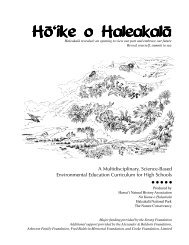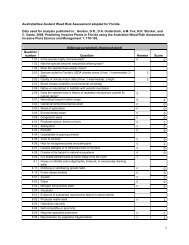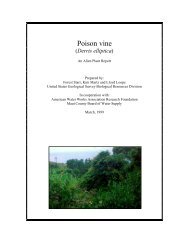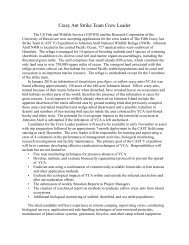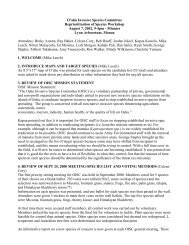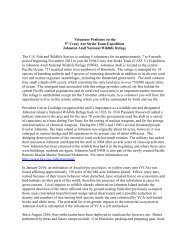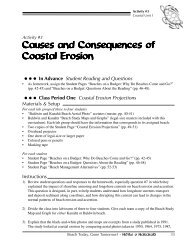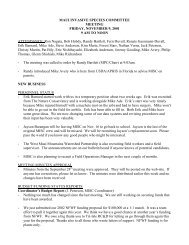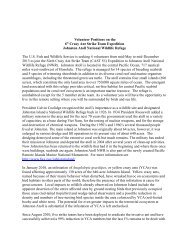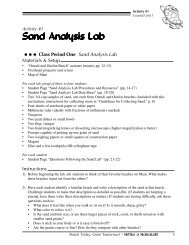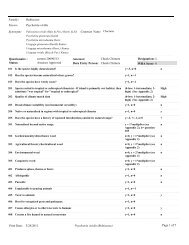Coccinia grandis on Maui - Hawaiian Ecosystems at Risk project
Coccinia grandis on Maui - Hawaiian Ecosystems at Risk project
Coccinia grandis on Maui - Hawaiian Ecosystems at Risk project
Create successful ePaper yourself
Turn your PDF publications into a flip-book with our unique Google optimized e-Paper software.
<str<strong>on</strong>g>Coccinia</str<strong>on</strong>g> <str<strong>on</strong>g>grandis</str<strong>on</strong>g><br />
Ivy gourd<br />
Cucurbitaceae<br />
Forest Starr, Kim Starr, and Lloyd Loope<br />
United St<strong>at</strong>es Geological Survey--Biological Resources Divisi<strong>on</strong><br />
Haleakala Field St<strong>at</strong>i<strong>on</strong>, <strong>Maui</strong>, Hawai'i<br />
January, 2003<br />
OVERVIEW<br />
Ivy gourd (Coccina <str<strong>on</strong>g>grandis</str<strong>on</strong>g>) is an aggressive vine in the Cucurbitaceae (cucumber)<br />
family. It is widely cultiv<strong>at</strong>ed and has escaped to become a vigorous pest in Hawai'i,<br />
Australia, Saipan, Texas, and Florida. In Hawai'i, ivy gourd has spread rapidly in<br />
H<strong>on</strong>olulu from Manoa Valley to Punchbowl and in Kailua, O'ahu, and also in Kailua-<br />
K<strong>on</strong>a, Hawai'i (Wagner et al. 1999). It is now also known from both east and west <strong>Maui</strong><br />
(Starr et al. 1999; Oppenheimer and Bartlett 2000). On Midway Atoll in 1999, a single<br />
plant was found in cultiv<strong>at</strong>i<strong>on</strong> and eradic<strong>at</strong>ed before it was able to spread (Starr and<br />
Martz 1999). On Kaua'i, C. <str<strong>on</strong>g>grandis</str<strong>on</strong>g> is currently restricted in distributi<strong>on</strong> and it is a target<br />
for eradic<strong>at</strong>i<strong>on</strong> by the Kaua'i Invasive Species Committee (KISC). On <strong>Maui</strong>, though<br />
numerous loc<strong>at</strong>i<strong>on</strong>s of ivy gourd have recently been found, the island wide distributi<strong>on</strong> is<br />
still limited and it has been targeted for eradic<strong>at</strong>i<strong>on</strong> by the <strong>Maui</strong> Invasive Species<br />
Committee (MISC).<br />
TAXONOMY<br />
Family: Cucurbitaceae (cucumber family) (Wagner et al. 1999).<br />
L<strong>at</strong>in name: <str<strong>on</strong>g>Coccinia</str<strong>on</strong>g> <str<strong>on</strong>g>grandis</str<strong>on</strong>g> (L.) Voigt (Wagner et al. 1999).<br />
Syn<strong>on</strong>yms: C. cordifolia (L.) Cogn., Bry<strong>on</strong>ia <str<strong>on</strong>g>grandis</str<strong>on</strong>g> L (PIER 2001).<br />
Comm<strong>on</strong> names: Ivy gourd, scarlet fruited gourd (Wagner et al. 1999).<br />
Tax<strong>on</strong>omic notes: The genus, <str<strong>on</strong>g>Coccinia</str<strong>on</strong>g>, is made up of about 30 species mostly from<br />
tropical Africa (Wagner et al. 1999).<br />
Nomencl<strong>at</strong>ure: The name is derived from the L<strong>at</strong>in coccineus, meaning scarlet, in<br />
reference to the fruit color (Wagner et al. 1999).<br />
Rel<strong>at</strong>ed species in Hawai'i: No other <str<strong>on</strong>g>Coccinia</str<strong>on</strong>g> are documented from Hawai'i.<br />
DESCRIPTION<br />
"Dioecious, climbing perennial herbs with a tuberous rootstock producing annual stems<br />
up to several m l<strong>on</strong>g, hispid. Leaves broadly ov<strong>at</strong>e in outline with a basal sinus, blades 3-<br />
10 cm l<strong>on</strong>g, 4-10 cm wide, 5 angled to palm<strong>at</strong>ely 3-7 lobed, the lobes shallow to deep and<br />
lobul<strong>at</strong>e, upper surface glabr<strong>at</strong>e, lower surface hispid and bearing 3-8 glands near<br />
<strong>at</strong>tachment of petiole and major vein branchings, margins denticul<strong>at</strong>e, apex obtuse,<br />
mucr<strong>on</strong><strong>at</strong>e, petioles 1-3 cm l<strong>on</strong>g, tendrils unbranched. Stamin<strong>at</strong>e flowers solitary, rarely<br />
in axillary clusters of 2-3, pedicels 15-50 mm l<strong>on</strong>g, calyx lobes subul<strong>at</strong>e, recurved, 2-5<br />
mm l<strong>on</strong>g, corolla lobes white, ov<strong>at</strong>e, 15-20 mm l<strong>on</strong>g; pistill<strong>at</strong>e flowers solitary <strong>on</strong> stalks<br />
10-30 mm l<strong>on</strong>g, hypanthium 10-15 mm l<strong>on</strong>g. Fruit red, ovoid to ellipsoid, 25-60 mm
l<strong>on</strong>g, 15-35 mm in diameter, glabrous, <strong>on</strong> stalks 10-40 mm l<strong>on</strong>g, pulp red. Seeds tan, 6-7<br />
mm l<strong>on</strong>g, margins thickened." (Wagner et al. 1999).<br />
BIOLOGY & ECOLOGY<br />
Cultiv<strong>at</strong>i<strong>on</strong>: In Southeast Asia, ivy gourd is cultiv<strong>at</strong>ed for its edible young shoots and<br />
edible fruits (Linney 1986). According to website Gardenbed.com (2001), "Young<br />
leaves and l<strong>on</strong>g slender stem tops are cooked and e<strong>at</strong>en as a potherb or added to soups.<br />
Young and tender green fruits are e<strong>at</strong>en raw in salads or cooked and added to curries.<br />
Ripe scarlet fruit is e<strong>at</strong>en raw." They also report <strong>on</strong> ivy gourds various medicinal<br />
qualities and say th<strong>at</strong>, "The juice of the roots and leaves is used in the tre<strong>at</strong>ment of<br />
diabetes. The leaves are used as a poultice in tre<strong>at</strong>ing skin erupti<strong>on</strong>s. The plant is used as<br />
a lax<strong>at</strong>ive. It is used internally in the tre<strong>at</strong>ment of g<strong>on</strong>orrhea. Aqueous and ethanolic<br />
extracts of the plant have shown hypoglycaemic principles."<br />
Invasiveness: Ivy gourd is an aggressive vine th<strong>at</strong> quickly smothers nearby plants or<br />
structures like a blanket. It has the potential to invade dry forest areas <strong>on</strong> <strong>Maui</strong> and out<br />
compete rare n<strong>at</strong>ive plants. According to Medeiros et al. (1993), "Its preference for dry,<br />
hot envir<strong>on</strong>ments and its smothering habit make <str<strong>on</strong>g>Coccinia</str<strong>on</strong>g> <str<strong>on</strong>g>grandis</str<strong>on</strong>g> well suited to<br />
potentially establish and choke out n<strong>at</strong>ive trees and seedlings in Kanaio NAR. If<br />
<str<strong>on</strong>g>Coccinia</str<strong>on</strong>g> does become established, it would not <strong>on</strong>ly trigger the decline of much of the<br />
remaining biota but also transform the visual landscape to even the most casual of<br />
observers." Ivy gourd can climb over trees and shrubs as well as <strong>on</strong> fences and power<br />
lines. It can cover archaeological sites such as heiaus. Ivy gourd is presumably spread<br />
by birds and perhaps r<strong>at</strong>s and other small mammals. In additi<strong>on</strong> to these invasive<br />
characteristics, it is not easily killed and will persist if even <strong>on</strong>e rooted stem is missed by<br />
the herbicide applic<strong>at</strong>i<strong>on</strong>.<br />
Pollin<strong>at</strong>i<strong>on</strong>: Unknown. On <strong>Maui</strong>, various Hymenoptera have bee observed in flowers,<br />
including bees (Apis melifera) and ants.<br />
Propag<strong>at</strong>i<strong>on</strong>: C. <str<strong>on</strong>g>grandis</str<strong>on</strong>g> is propag<strong>at</strong>e from seeds or cuttings.<br />
Dispersal: Ivy gourd is dispersed l<strong>on</strong>g distances by humans who grow the plant for food.<br />
Seeds of the plant or pieces of the vine can be dispersed to produce new plants. This can<br />
occur when organic debris or equipment c<strong>on</strong>taining C. <str<strong>on</strong>g>grandis</str<strong>on</strong>g> is moved. Once<br />
established, it is spread by birds and possibly other animals th<strong>at</strong> e<strong>at</strong> the fruit. PIER<br />
(2001) suggests th<strong>at</strong> the fruit may be dispersed by pigs. Pieces of ivy gourd can also be<br />
moved unintenti<strong>on</strong>ally <strong>on</strong> equipment or <strong>on</strong> wood and sprout where they land.<br />
Pests and Diseases: Two weevils and a moth have been introduced to Hawai'i as<br />
biological c<strong>on</strong>trol of ivy gourd.<br />
DISTRIBUTION<br />
N<strong>at</strong>ive range: Ivy gourd is n<strong>at</strong>ive to Africa, India Asia, and Australia (PIER 2001;<br />
Wagner et al. 1999). Though, according to the Department of Agriculture of Western<br />
Australia (DOA-WA 2001), it is an introduced weed there.<br />
2
Global distributi<strong>on</strong>: Ivy gourd was first recorded in the Pacific Islands in Fiji in 1940<br />
(Whistler 1994). In Micr<strong>on</strong>esia, it is present in the comm<strong>on</strong>wealth of the Northern<br />
Mariana Islands (Saipan), Guam, Feder<strong>at</strong>ed St<strong>at</strong>es of Micr<strong>on</strong>esia (introduced to Pohnpei),<br />
and the Republic of the Marshall Islands (Majuro) (PIER 2001). Apparently, it has been<br />
stopped from invading Rota and Tinian Islands in the Northern Marianas (NMC 2001).<br />
In Australia, there are references th<strong>at</strong> say th<strong>at</strong> ivy gourd is n<strong>at</strong>ive (Wagner et al. 1999).<br />
Perhaps it is n<strong>at</strong>ive to the northern regi<strong>on</strong>s, however, it is reported as a weed in western<br />
Australia. Small infest<strong>at</strong>i<strong>on</strong>s have been reported from Broome, South Hedland, Arnhem<br />
Land and Queensland, Australia (DOA-WA 2001). In the United St<strong>at</strong>es of America, ivy<br />
gourd is present in Texas and Florida and is declared as a st<strong>at</strong>e noxious weed in Hawai'i<br />
(PLANTS 2001).<br />
St<strong>at</strong>e of Hawai'i distributi<strong>on</strong>: In the St<strong>at</strong>e of Hawai'i, ivy gourd has been found <strong>on</strong><br />
Hawai'i, <strong>Maui</strong>, Lana'i, O'ahu, Kaua'i, and Midway Atoll.<br />
Hawai'i: On the Big Island (Hawai'i), ivy gourd was first observed <strong>at</strong> Kamoa Point in<br />
K<strong>on</strong>a in 1986 (Linney 1986). Ivy gourd is now widespread in Kailua-K<strong>on</strong>a (Wagner et<br />
al. 1999) where it grows from sea level up to an elev<strong>at</strong>i<strong>on</strong> of 800 ft (Uchida and<br />
Beardsley 1990). Ivy gourd has been called, "the cucumber th<strong>at</strong> <strong>at</strong>e Kailua" (Hannah<br />
Springer pers. comm). During a recent survey of Kealakekua, Starr and Martz (2000)<br />
reported the following. "<str<strong>on</strong>g>Coccinia</str<strong>on</strong>g> <str<strong>on</strong>g>grandis</str<strong>on</strong>g>, an aggressive alien vine th<strong>at</strong> tends to outcompete<br />
all other plants, is currently germin<strong>at</strong>ing <strong>on</strong> Hikiau Heiau. If not removed, ivy<br />
gourd could work its way into the nooks and crannies of the structure, and potentially<br />
alter the structure."<br />
O'ahu: On O'ahu, it appears th<strong>at</strong> <str<strong>on</strong>g>Coccinia</str<strong>on</strong>g> <str<strong>on</strong>g>grandis</str<strong>on</strong>g> was originally grown in cultiv<strong>at</strong>i<strong>on</strong><br />
some time in the l<strong>at</strong>e 1960's and early 1970's <strong>at</strong> Ly<strong>on</strong> Arboretum and th<strong>at</strong> wild<br />
popul<strong>at</strong>i<strong>on</strong>s were found by 1985. Uchida and Beardsley (1990) reviewed specimens of<br />
<str<strong>on</strong>g>Coccinia</str<strong>on</strong>g> <str<strong>on</strong>g>grandis</str<strong>on</strong>g> <strong>at</strong> Bishop Museum and the Harold Ly<strong>on</strong> Arboretum and found the<br />
earliest collecti<strong>on</strong> made by Nag<strong>at</strong>a in 1968 in the Punchbowl area of O'ahu. Linney<br />
(1986) reports th<strong>at</strong> <str<strong>on</strong>g>Coccinia</str<strong>on</strong>g> <str<strong>on</strong>g>grandis</str<strong>on</strong>g> seeds were received and grown by Ly<strong>on</strong> Arboretum<br />
in 1969. Uchida and Beardsley (1990) also report, "the first plants were planted <strong>on</strong> the<br />
grounds of the Ly<strong>on</strong> Arboretum in 1970 and the first specimen bearing flowers was<br />
collected by Herbst and Ishikawa in 1974. In the spring of 1985, feral C. <str<strong>on</strong>g>grandis</str<strong>on</strong>g> was<br />
collected by Smith in Keolu Hills in Kailua." Wagner et al. (1999) report 1986 as the<br />
d<strong>at</strong>e of first collecti<strong>on</strong> <strong>on</strong> O'ahu.<br />
<strong>Maui</strong>: On <strong>Maui</strong>, ivy gourd was first found in Kahului's industrial district (Robert Hobdy<br />
pers comm.) in 1992 growing <strong>on</strong> a fence of a lumber yard. It may have been introduced<br />
<strong>on</strong> lumber (Rezents 1998). Within a few years, two more sites were found, <strong>on</strong>e near the<br />
Youth Center in Kihei and <strong>on</strong>e <strong>on</strong> a fence <strong>at</strong> a chicken farm in Makawao. In 1997, <strong>on</strong>e of<br />
the largest infest<strong>at</strong>i<strong>on</strong>s was found near the mouth of Iao stream. Multiple ivy gourd<br />
infest<strong>at</strong>i<strong>on</strong>s have now been found in Kapalua, Lahaina, Kihei, Kahului, Waikapu,<br />
Makawao, Paia, and Haiku. A more detailed descripti<strong>on</strong> of the history and distributi<strong>on</strong><br />
<strong>on</strong> ivy gourd <strong>on</strong> <strong>Maui</strong> is found below.<br />
3
Lana'i: Ivy gourd was purposefully introduced to Lana'i for its edible shoots (Rezents<br />
1998). It is uncertain whether this plant still exists.<br />
Kaua'i: On Kaua'i, a small infest<strong>at</strong>i<strong>on</strong> was found in 1997 in Anahola Valley and<br />
eradic<strong>at</strong>i<strong>on</strong> efforts were launched. It is now known from Anahola, Moloa, Kapaa, and<br />
Nawiliwili, covering an estim<strong>at</strong>ed 20 plus acres, and is a KISC target species.<br />
Northwestern <strong>Hawaiian</strong> Islands (NWHI): On Midway Atoll, a single ivy gourd plant was<br />
found and eradic<strong>at</strong>ed in 1999 (Starr and Martz 1999). It had been brought in as seeds<br />
from Thailand and grown <strong>on</strong> Midway. The plant was in cultiv<strong>at</strong>i<strong>on</strong> and was sprawling<br />
al<strong>on</strong>g a fence in the yard. Through early detecti<strong>on</strong> and rapid resp<strong>on</strong>se, this noxious weed<br />
has been eradic<strong>at</strong>ed from Midway Atoll. Ivy gourd was not found <strong>on</strong> any other <strong>at</strong>olls in<br />
the NWHI (Starr and Martz 1999b).<br />
Island of <strong>Maui</strong> distributi<strong>on</strong>: Ivy gourd was first observed <strong>on</strong> <strong>Maui</strong> in 1992 in Kahului<br />
and Kihei. Today, several infest<strong>at</strong>i<strong>on</strong>s have been documented in Kahului, Iao, Waikapu,<br />
Kihei, Lahaina, Kapalua, Makawao, Paia, and Ha'iku. Ivy gourd is currently being<br />
c<strong>on</strong>trolled by the Department of Agriculture (DOA) and MISC. New loc<strong>at</strong>i<strong>on</strong>s are still<br />
being found, though mostly nearby known infest<strong>at</strong>i<strong>on</strong>s. The following is a brief<br />
summary of ivy gourd <strong>on</strong> <strong>Maui</strong>.<br />
Kahului: Ivy gourd was first reported in Kahului's industrial district in 1992 (Robert<br />
Hobdy pers. comm. 1993). Plants were c<strong>on</strong>trolled then by hand pulling. Follow up<br />
chemical tre<strong>at</strong>ments using a basal bark applic<strong>at</strong>i<strong>on</strong> of Garl<strong>on</strong> 4 were d<strong>on</strong>e in 1998 and<br />
new growth has not been seen there since. Other loc<strong>at</strong>i<strong>on</strong>s have been found nearby in the<br />
industrial district. Ivy gourd is usually found in this area growing al<strong>on</strong>g fences in a<br />
sprawling habit.<br />
Makawao: Ivy gourd was first found <strong>on</strong> Makani Rd. in Makawao in 1994 growing <strong>on</strong> a<br />
fence <strong>at</strong> a chicken farm. Several <strong>at</strong>tempts <strong>at</strong> c<strong>on</strong>trol by hand pulling as well as chemical<br />
tre<strong>at</strong>ment have been d<strong>on</strong>e, though the plant still persists today.<br />
Iao: Ivy gourd was first found <strong>at</strong> a residence <strong>at</strong> the mouth of Iao Stream in 1997 by Starr<br />
and Martz. At the time, <strong>on</strong>ly a few (about 3) other sites were known and this <strong>on</strong>e was by<br />
far the largest infest<strong>at</strong>i<strong>on</strong>. The Department of Agriculture began c<strong>on</strong>trol and today, the<br />
site still persists, but there is much less now.<br />
Waikapu/Wailuku: Ivy gourd was first found in Waikapu in 1998 by Starr and Martz<br />
during a survey of a nursery. The infest<strong>at</strong>i<strong>on</strong> is <strong>on</strong> a mulch pile behind the Kihei<br />
Landscape and Foliage Company. A few other sites have also been found more recently<br />
in nearby areas.<br />
Kihei: Ivy gourd was first found in Kihei in 1992 by Robert Hobdy <strong>at</strong> the Kihei Youth<br />
Center. Ivy gourd has since spread from the initial loc<strong>at</strong>i<strong>on</strong> into nearby residential areas.<br />
There are currently about 2-3 dozen loc<strong>at</strong>i<strong>on</strong>s in north Kihei from the Youth Center to the<br />
4
<strong>Maui</strong> Lu. Most homeowners say they did not plant the vine and th<strong>at</strong> it came <strong>on</strong> its own.<br />
Some of the sites were completely eradic<strong>at</strong>ed while others still persist. New plants are<br />
c<strong>on</strong>tinually being found in the area. There is also now a single infest<strong>at</strong>i<strong>on</strong> in the <strong>Maui</strong><br />
Meadows area in south Kihei. This is the first loc<strong>at</strong>i<strong>on</strong> above the Pi'ilani Hwy. and quite<br />
a significant outlier to the south.<br />
Lahaina: Ivy gourd was first found in Lahaina by Robert Hobdy around 1997 <strong>on</strong> Waine'e<br />
St. This large infest<strong>at</strong>i<strong>on</strong> has been c<strong>on</strong>trolled, however, re-growth is present. Several<br />
other sites nearby have recently been found al<strong>on</strong>g the H<strong>on</strong>oapi'ilani Hwy. from Puamana<br />
to Ka'anapali.<br />
Kapalua: Ivy gourd was first found in Kapalua in 1998 by Starr and Martz <strong>at</strong> the<br />
H<strong>on</strong>olua store. Since then it has been found in several other sites nearby. The biological<br />
c<strong>on</strong>trol agents have been released <strong>at</strong> the Kapalua infest<strong>at</strong>i<strong>on</strong>s.<br />
Ha'iku: A single loc<strong>at</strong>i<strong>on</strong> found in 1998 by Starr and Martz <strong>on</strong> West Kuiaha Rd. This<br />
site has been c<strong>on</strong>trolled by MISC.<br />
Paia: A single loc<strong>at</strong>i<strong>on</strong> found in 2000 by Starr and Martz in Paia town. Recently, a<br />
sec<strong>on</strong>d popul<strong>at</strong>i<strong>on</strong> was loc<strong>at</strong>ed by MISC <strong>at</strong> the Paia post office, growing <strong>on</strong> a fence.<br />
CONTROL METHODS<br />
The most effective method of c<strong>on</strong>trol to completely kill ivy gourd with minimal followup<br />
is thin line basal bark tre<strong>at</strong>ment with 100% Garl<strong>on</strong> 4.<br />
Physical c<strong>on</strong>trol: Except for bagging fruits, physical c<strong>on</strong>trol is not recommended.<br />
Grubbing or hand-pulling generally does not kill the plant. R<strong>at</strong>her, it breaks up into<br />
multiple plantlets which can grow back from roots or stems th<strong>at</strong> touch the ground. This<br />
method can c<strong>on</strong>vey a false sense of success and often makes future c<strong>on</strong>trol efforts more<br />
difficult. Picking fruits off the plants and placing them in a plastic trash bag helps<br />
decrease the seed bank under the plant. Double bag and dispose of fruits properly. It<br />
may be best to leave vines in place to allow transloc<strong>at</strong>i<strong>on</strong> of herbicide.<br />
Chemical c<strong>on</strong>trol:<br />
Thin-line basal bark: Ivy gourd plants have resp<strong>on</strong>ded well to a thin-line basal bark<br />
applic<strong>at</strong>i<strong>on</strong> of 100% Garl<strong>on</strong> 4 (triclopyr). If there are multiple stems, apply multiple<br />
times. Make sure to get each secti<strong>on</strong> th<strong>at</strong> touches the ground. Leave plants in place. Try<br />
not to pull plants out of trees or off of walls or fences, as this multiplies the number of<br />
plants and prevents transloc<strong>at</strong>i<strong>on</strong> of the herbicide. On Kaua'i, KISC plans to use Spike or<br />
Garl<strong>on</strong> to tre<strong>at</strong> the vines.<br />
Cut stump: This method is not recommended as it will lead to multiplying plants and<br />
prevents transloc<strong>at</strong>i<strong>on</strong> of herbicide to the rest of the vine.<br />
Biological c<strong>on</strong>trol: Several species have been introduced to Hawai'i for biological<br />
c<strong>on</strong>trol of ivy gourd. Two weevils, Acythopeus burkhartorum and A. cocciniae were<br />
5
introduced by the DOA <strong>on</strong> O'ahu and Hawai'i. A. cocciniae has also been released <strong>on</strong><br />
<strong>Maui</strong>. African vine moths, also called the ivy gourd vine borer (Melittia oedipus), were<br />
also released <strong>on</strong> O'ahu and <strong>Maui</strong>. On <strong>Maui</strong>, A. cocciniae is established in Kapalua and<br />
seems to be damaging leaves of C. <str<strong>on</strong>g>grandis</str<strong>on</strong>g> plants in the area. The larva of the beetle feed<br />
in a leaf mining manner and the adults chew holes in the leaves. A. cocciniae seems<br />
capable of finding other C. <str<strong>on</strong>g>grandis</str<strong>on</strong>g> plants, as beetles were found in areas where they<br />
were not released. The moth, Melittia oedipus, has also been released <strong>at</strong> Kapalua.<br />
Deformed vines where moth larva had bored were sparingly observed, though it is not yet<br />
as well established as the beetle, A. cocciniae.<br />
Cultural c<strong>on</strong>trol: Ivy gourd is a noxious weed in Hawai'i, making it illegal to possess,<br />
propag<strong>at</strong>e, or grow. Infest<strong>at</strong>i<strong>on</strong>s should be reported to the DOA or to MISC (<strong>on</strong> <strong>Maui</strong>).<br />
Noxious weed acts: In the United St<strong>at</strong>es, ivy gourd is a st<strong>at</strong>e noxious weed in the st<strong>at</strong>e<br />
of Hawai'i (PLANTS 2001). In Australia, ivy gourd is a declared plant in the Kimberley<br />
regi<strong>on</strong> of Western Australia (DOA-WA 2001).<br />
MANAGEMENT RECOMMENDATIONS<br />
There are numerous infest<strong>at</strong>i<strong>on</strong>s in lowland areas of <strong>Maui</strong>, though it is still rel<strong>at</strong>ively<br />
limited in distributi<strong>on</strong> and not nearly as widespread as <strong>on</strong> O'ahu and Hawai'i. C<strong>on</strong>trol is<br />
most efficient using a basal bark applic<strong>at</strong>i<strong>on</strong> of 100% Garl<strong>on</strong> 4. Other methods such as<br />
hand pulling or cut stump have proved less effective <strong>at</strong> killing the entire infest<strong>at</strong>i<strong>on</strong>.<br />
Follow up c<strong>on</strong>trol is necessary in a timely manner to effectively kill any parts of plants<br />
missed during the original applic<strong>at</strong>i<strong>on</strong>. Surveys of all the roads <strong>on</strong> <strong>Maui</strong> proved effective<br />
<strong>at</strong> loc<strong>at</strong>ing new popul<strong>at</strong>i<strong>on</strong>s of ivy gourd. Foot surveys are also recommended especially<br />
near and adjacent to existing infest<strong>at</strong>i<strong>on</strong>s. The DOA, MISC, and people of <strong>Maui</strong> will<br />
have to act swiftly if they wish to eradic<strong>at</strong>e ivy gourd. The eradic<strong>at</strong>i<strong>on</strong> of C. <str<strong>on</strong>g>grandis</str<strong>on</strong>g> <strong>on</strong><br />
Midway Atoll proves th<strong>at</strong> it is possible to prevent the establishment of a weedy invader if<br />
it is found and c<strong>on</strong>trolled early.<br />
REFERENCES<br />
DOA-WA. 2001. Ivy Gourd. Department of Agriculture, Western Australia.<br />
http://www.agric.wa.gov.au/agency/offices/Derby/rubb.htm (Accessed: October 30,<br />
2001).<br />
Gardenbed.com. 2001. <str<strong>on</strong>g>Coccinia</str<strong>on</strong>g> <str<strong>on</strong>g>grandis</str<strong>on</strong>g>. Plants for a Future.<br />
http://gardenbed.com/source/18/1800_med.asp (Accessed: October 30, 2001).<br />
Linney, G. 1986. <str<strong>on</strong>g>Coccinia</str<strong>on</strong>g> <str<strong>on</strong>g>grandis</str<strong>on</strong>g> (L.) Voight: A new cucurbitaceous weed in Hawai'i.<br />
Hawaii. Bot. Soc. Newslett. 25(1):3-5.<br />
Medeiros, A.C., L.L. Loope, and C.G. Chimera. March 1993. Kanaio N<strong>at</strong>ural Area<br />
Reserve Biological Inventory and Management Recommend<strong>at</strong>i<strong>on</strong>s. Report for N<strong>at</strong>ural<br />
Area Reserve System, St<strong>at</strong>e of HI.<br />
6
NMC-CNMI CREES. 2001. Weed C<strong>on</strong>trol. Northern Marianas College –<br />
Comm<strong>on</strong>wealth of the Northern Marianas Islands, Cooper<strong>at</strong>ive Research Extensi<strong>on</strong> and<br />
Educ<strong>at</strong>i<strong>on</strong> Service. http://crees.ort/weeds/default.htm (Accessed: October 31, 2001).<br />
Oppenheimer, H.L. and R.T. Bartlett. 2000. New Plant Records from <strong>Maui</strong>, O'ahu, and<br />
Hawai'i Islands. Bishop Mus. Occ. Pap. 64:1-10.<br />
PIER (Paciric Island <strong>Ecosystems</strong> <strong>at</strong> <strong>Risk</strong>). 2001. "Invasive plant species: <str<strong>on</strong>g>Coccinia</str<strong>on</strong>g><br />
<str<strong>on</strong>g>grandis</str<strong>on</strong>g>." Pacific Island <strong>Ecosystems</strong> <strong>at</strong> <strong>Risk</strong>. Available: http://www.hear.org/pier/<br />
(Accessed: October 30, 2001).<br />
PLANTS (N<strong>at</strong>i<strong>on</strong>al Plants D<strong>at</strong>abase). 2001. Online d<strong>at</strong>abase. United St<strong>at</strong>es Department<br />
of Agriculture, N<strong>at</strong>ural Resources C<strong>on</strong>serv<strong>at</strong>i<strong>on</strong> Services, N<strong>at</strong>i<strong>on</strong>al Plant D<strong>at</strong>a Center,<br />
B<strong>at</strong><strong>on</strong> Rouge, LA. Available: http://plants.usda.gov (Accessed: October 30, 2001).<br />
Rezents, E. 1998. Alien Species: Invasive Alien Species Wreaking Havoc in Hawai'i.<br />
The <strong>Maui</strong> Weekly Wrap. <strong>Maui</strong> News (March 10-18, 1998).<br />
Starr and Martz. 2000. Botanical Survey Kealakekua Bay St<strong>at</strong>e Historical Park Island of<br />
Hawai'i. Report for Belt Collins, Inc., H<strong>on</strong>olulu, HI.<br />
Starr, F., K. Martz, and L.L. Loope 1999. New Plant Records from East <strong>Maui</strong> for 1998.<br />
Bishop Mus. Occ. Pap. 59:11-15.<br />
Starr, F. and K. Martz. 1999. Botanical Survey of Midway Atoll: 1999 Upd<strong>at</strong>e. Report<br />
prepared for Midway Atoll N<strong>at</strong>i<strong>on</strong>al Wildlife Refuge, United St<strong>at</strong>es Fish and Wildlife<br />
Service, H<strong>on</strong>olulu, HI.<br />
Starr, F. and K. Martz. 1999b. S.S. Midway Expediti<strong>on</strong>. Report for United St<strong>at</strong>es Fish<br />
and Wildlife Service, H<strong>on</strong>olulu, HI.<br />
Uchida, G.K. and J.W. Beardsley, Jr. 1990?. Notes <strong>on</strong> <str<strong>on</strong>g>Coccinia</str<strong>on</strong>g> <str<strong>on</strong>g>grandis</str<strong>on</strong>g> (L.) Voigt<br />
(Cucurbitaceae), its distributi<strong>on</strong> and potential as a reservoir host of the mel<strong>on</strong> fly Dacus<br />
cucurbitae Coquillett (Diptera: Tephritidae), in Hawai'i. Proc. Hawaii. Entol. Soc.<br />
Wagner, W.L., D.R. Herbst, and S.H. Sohmer. 1999. Manual of the Flowering Plants of<br />
Hawai'i. 2 vols. Bishop Museum Special Public<strong>at</strong>i<strong>on</strong> 83, University of Hawai'i and<br />
Bishop Museum Press, H<strong>on</strong>olulu, HI.<br />
Whistler, W.A. 1994. Wayside weeds of the Islands. Isle Botanica, H<strong>on</strong>olulu, HI.<br />
7



